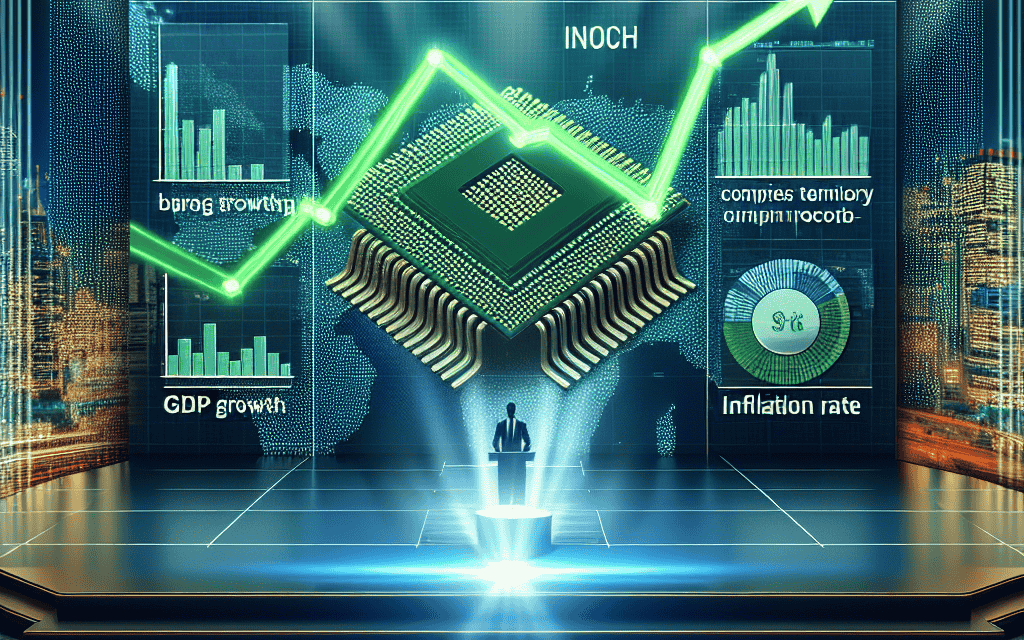“Chip Stocks Soar, Futures Brighten: Economic Data in the Spotlight”
Introduction
Chip stocks experienced a significant surge, propelling futures upward as investors closely monitored the latest economic data releases. This rally in semiconductor shares provided a positive momentum in the markets, reflecting optimism about the sector’s growth prospects and its critical role in the technology-driven economy. Meanwhile, market participants turned their attention to key economic indicators, seeking insights into the broader economic landscape and potential policy implications. The interplay between robust chip stock performance and pivotal economic data underscored the dynamic nature of the financial markets, highlighting the factors influencing investor sentiment and market direction.
Chip Stocks Surge: Key Drivers Behind the Rally
The recent surge in chip stocks has captured the attention of investors and analysts alike, as the semiconductor industry experiences a significant rally. This upward momentum in chip stocks has, in turn, provided a substantial boost to futures markets, underscoring the critical role that the semiconductor sector plays in the broader economic landscape. Several key drivers have contributed to this rally, each playing a pivotal role in shaping the current market dynamics.
To begin with, the global demand for semiconductors has been on a steady rise, driven by the increasing reliance on technology across various sectors. From consumer electronics to automotive and industrial applications, semiconductors are the backbone of modern technology. The proliferation of devices such as smartphones, laptops, and smart home gadgets has fueled this demand, while the automotive industry’s shift towards electric and autonomous vehicles has further amplified the need for advanced chips. This growing demand has created a favorable environment for chip manufacturers, leading to increased investor confidence and a subsequent surge in stock prices.
Moreover, the ongoing advancements in technology, particularly in areas such as artificial intelligence, 5G, and the Internet of Things (IoT), have further bolstered the semiconductor industry’s prospects. These technologies require sophisticated and high-performance chips, prompting companies to invest heavily in research and development to stay competitive. As a result, investors are optimistic about the long-term growth potential of chip manufacturers, contributing to the current rally in stock prices.
In addition to demand-driven factors, supply chain dynamics have also played a crucial role in the recent surge of chip stocks. The semiconductor industry has faced significant supply chain disruptions over the past few years, exacerbated by the COVID-19 pandemic and geopolitical tensions. These disruptions have highlighted the importance of securing a stable supply of chips, prompting governments and companies to invest in domestic manufacturing capabilities. This shift towards localized production has alleviated some of the supply chain pressures, providing a more stable environment for chip manufacturers and boosting investor confidence.
Furthermore, the financial performance of leading semiconductor companies has been a key driver behind the rally. Many of these companies have reported strong earnings, driven by robust demand and improved operational efficiencies. This positive financial performance has reassured investors about the industry’s resilience and growth prospects, leading to increased buying activity in the stock market.
While the surge in chip stocks has undoubtedly been a significant factor in boosting futures, it is essential to consider the broader economic context. Economic data releases have taken center stage, influencing market sentiment and shaping investor expectations. Key indicators such as employment figures, inflation rates, and GDP growth provide valuable insights into the health of the economy, impacting investment decisions across various sectors, including semiconductors.
In conclusion, the recent rally in chip stocks can be attributed to a combination of factors, including rising global demand, technological advancements, improved supply chain dynamics, and strong financial performance. These elements have collectively contributed to increased investor confidence and a subsequent boost in futures markets. However, it is crucial to remain attentive to economic data releases, as they continue to play a vital role in shaping market sentiment and influencing the trajectory of the semiconductor industry. As the landscape evolves, investors and analysts will closely monitor these developments to navigate the opportunities and challenges that lie ahead.
Economic Data’s Role in Shaping Market Sentiment
In recent weeks, the financial markets have witnessed a notable surge in chip stocks, which has significantly influenced futures trading. This upward momentum in the semiconductor sector has been driven by a combination of robust earnings reports and optimistic forecasts for future growth. As a result, investors have shown increased confidence in the technology sector, propelling futures to new heights. However, while the rally in chip stocks has captured headlines, it is the broader economic data that continues to play a pivotal role in shaping market sentiment.
Economic indicators, such as employment figures, inflation rates, and consumer spending, provide critical insights into the health of the economy. These data points are closely monitored by investors and policymakers alike, as they offer valuable clues about future economic conditions. For instance, a strong jobs report can signal a healthy labor market, which in turn may lead to increased consumer spending and economic growth. Conversely, rising inflation rates can raise concerns about the purchasing power of consumers and the potential for tighter monetary policy.
In this context, the recent release of key economic data has garnered significant attention. Market participants are keenly aware that these figures can either reinforce or undermine the optimism generated by the surge in chip stocks. For example, if economic data suggests that inflation is accelerating faster than anticipated, it could prompt the Federal Reserve to consider raising interest rates sooner than expected. Such a move could dampen investor enthusiasm and lead to a reassessment of risk across various asset classes.
Moreover, the interplay between economic data and market sentiment is not limited to domestic factors. Global economic conditions also exert a considerable influence on investor behavior. For instance, developments in major economies such as China and the European Union can have ripple effects across global markets. A slowdown in China’s manufacturing sector or political uncertainty in Europe can create volatility and impact investor confidence worldwide. Therefore, market participants must remain vigilant and consider a wide array of economic indicators when making investment decisions.
In addition to traditional economic data, emerging trends such as digital transformation and sustainability are increasingly shaping market sentiment. Companies that are at the forefront of technological innovation or are committed to sustainable practices are often viewed favorably by investors. This shift in focus reflects a broader recognition of the importance of long-term value creation and risk management. As a result, economic data related to technology adoption and environmental impact is becoming more relevant in assessing the potential for future growth.
In conclusion, while the recent surge in chip stocks has provided a boost to futures, it is the broader economic data that remains central to shaping market sentiment. Investors must navigate a complex landscape of domestic and global indicators, balancing short-term market movements with long-term economic trends. As the world continues to grapple with challenges such as inflation, geopolitical tensions, and technological disruption, the role of economic data in guiding investment decisions is more crucial than ever. By staying informed and adaptable, market participants can better position themselves to capitalize on opportunities and mitigate risks in an ever-evolving economic environment.
How Chip Stocks Are Influencing Futures Markets
The recent surge in chip stocks has significantly influenced futures markets, capturing the attention of investors and analysts alike. This development comes at a time when economic data is increasingly taking center stage, providing a complex backdrop for market participants to navigate. As the semiconductor industry experiences a robust upswing, its impact on futures markets underscores the interconnectedness of global financial systems and the pivotal role that technology plays in shaping economic landscapes.
To begin with, the semiconductor sector has long been a bellwether for technological advancement and economic growth. The recent rally in chip stocks can be attributed to several factors, including increased demand for advanced technologies, supply chain improvements, and strategic investments by major industry players. As companies continue to innovate and expand their product offerings, the demand for semiconductors has surged, driving stock prices higher. This upward momentum in chip stocks has, in turn, influenced futures markets, as investors anticipate continued growth and profitability in the sector.
Moreover, the influence of chip stocks on futures markets is not limited to the technology sector alone. The ripple effects extend to various industries that rely heavily on semiconductors, such as automotive, consumer electronics, and telecommunications. As these industries experience growth, they contribute to broader economic expansion, which is reflected in futures markets. Consequently, the performance of chip stocks serves as a barometer for investor sentiment and economic outlook, influencing trading strategies and market dynamics.
In addition to the surge in chip stocks, economic data has emerged as a critical factor shaping futures markets. Recent reports on employment, inflation, and consumer spending have provided valuable insights into the health of the global economy. As central banks and policymakers closely monitor these indicators, their decisions on interest rates and monetary policy have far-reaching implications for financial markets. Investors, therefore, pay keen attention to economic data releases, as they offer clues about future market trends and potential investment opportunities.
The interplay between chip stocks and economic data highlights the complexity of modern financial markets. On one hand, the strong performance of the semiconductor sector boosts investor confidence and supports bullish sentiment in futures markets. On the other hand, economic data can introduce volatility, as market participants react to new information and adjust their expectations accordingly. This dynamic creates a challenging environment for investors, who must balance optimism about technological advancements with caution regarding economic uncertainties.
Furthermore, the global nature of the semiconductor industry adds another layer of complexity to the situation. As chip manufacturers operate across multiple countries and regions, geopolitical factors and trade policies can significantly impact their operations and, by extension, futures markets. For instance, tensions between major economies or disruptions in global supply chains can lead to fluctuations in chip stock prices, influencing investor sentiment and market movements.
In conclusion, the surge in chip stocks has played a crucial role in shaping futures markets, reflecting the broader economic trends and technological advancements that define the current financial landscape. As economic data continues to take center stage, investors must remain vigilant and adaptable, navigating the intricate web of factors that influence market dynamics. By understanding the interplay between chip stocks and economic indicators, market participants can make informed decisions and capitalize on emerging opportunities in an ever-evolving financial environment.
The Impact of Economic Indicators on Tech Stocks

The recent surge in chip stocks has significantly influenced futures markets, drawing attention to the broader implications of economic indicators on technology stocks. As investors navigate the complexities of the financial landscape, the interplay between economic data and tech stock performance becomes increasingly crucial. This dynamic relationship underscores the importance of understanding how various economic indicators can impact the technology sector, particularly semiconductor companies, which are often seen as bellwethers for the industry.
To begin with, the performance of chip stocks is often closely tied to economic indicators such as manufacturing output, consumer demand, and global trade dynamics. For instance, when manufacturing activity is robust, there is typically an increased demand for semiconductors, which are essential components in a wide array of products, from consumer electronics to industrial machinery. Consequently, positive manufacturing data can lead to a surge in chip stocks, as investors anticipate higher revenues and profits for semiconductor companies. This, in turn, can boost futures markets, as traders adjust their expectations for the technology sector’s performance.
Moreover, consumer demand plays a pivotal role in shaping the fortunes of tech stocks. Economic indicators such as retail sales and consumer confidence indices provide valuable insights into consumer spending patterns, which directly affect the demand for technology products. When consumers are confident and willing to spend, there is often a corresponding increase in the purchase of tech gadgets and devices, driving up the demand for semiconductors. As a result, strong consumer demand can lead to a rally in chip stocks, further influencing futures markets.
In addition to domestic economic indicators, global trade dynamics also have a significant impact on the technology sector. The semiconductor industry is highly globalized, with supply chains spanning multiple countries. Therefore, trade policies, tariffs, and geopolitical tensions can all affect the flow of goods and materials necessary for chip production. For example, favorable trade agreements or the easing of trade tensions can lead to a more stable supply chain, boosting investor confidence in chip stocks. Conversely, trade disruptions can lead to supply shortages and increased production costs, negatively impacting the performance of semiconductor companies and, by extension, tech stocks.
Furthermore, monetary policy decisions by central banks can also influence the technology sector. Interest rates, for instance, affect the cost of borrowing for companies, including those in the tech industry. Lower interest rates can encourage investment in technology and innovation, leading to growth in the sector. Conversely, higher interest rates can increase borrowing costs, potentially slowing down investment and innovation. As central banks adjust their monetary policies in response to economic indicators such as inflation and employment data, the technology sector can experience varying levels of impact.
In conclusion, the surge in chip stocks and its effect on futures markets highlight the intricate relationship between economic indicators and the performance of technology stocks. By closely monitoring manufacturing output, consumer demand, global trade dynamics, and monetary policy decisions, investors can gain a better understanding of the factors driving the technology sector. As economic data continues to take center stage, its influence on tech stocks remains a critical consideration for market participants seeking to navigate the ever-evolving financial landscape.
Analyzing the Correlation Between Chip Stocks and Economic Data
The recent surge in chip stocks has captured the attention of investors and analysts alike, as it has significantly influenced futures markets. This development comes at a time when economic data is increasingly taking center stage, providing a complex backdrop for market participants to navigate. Understanding the correlation between chip stocks and economic data is crucial for investors seeking to make informed decisions in this dynamic environment.
To begin with, the semiconductor industry is often viewed as a bellwether for the broader technology sector and, by extension, the global economy. This is because semiconductors are integral components in a wide array of products, from consumer electronics to industrial machinery. Consequently, the performance of chip stocks can offer valuable insights into economic trends and consumer demand. When chip stocks surge, it often signals robust demand for technology products, which can be indicative of economic expansion. Conversely, a decline in chip stocks might suggest a slowdown in economic activity.
The recent rally in chip stocks has been driven by several factors, including strong earnings reports from major semiconductor companies and increased demand for chips in emerging technologies such as artificial intelligence and electric vehicles. These developments have bolstered investor confidence, leading to a positive impact on futures markets. As futures are essentially bets on the direction of market indices, the rise in chip stocks has contributed to an optimistic outlook for the broader market.
However, while the surge in chip stocks is a positive indicator, it is essential to consider the broader economic context. Economic data releases, such as employment figures, inflation rates, and GDP growth, play a critical role in shaping market sentiment. For instance, strong employment data can boost consumer confidence and spending, further driving demand for technology products and supporting chip stocks. On the other hand, rising inflation can lead to increased production costs for semiconductor companies, potentially dampening their profitability and affecting stock performance.
Moreover, central bank policies, particularly those related to interest rates, are closely watched by investors as they can influence both economic growth and market dynamics. In periods of low interest rates, borrowing costs are reduced, encouraging investment in technology and innovation, which can benefit chip stocks. Conversely, when central banks raise interest rates to combat inflation, it can lead to tighter financial conditions, potentially impacting the growth prospects of the semiconductor industry.
In this intricate interplay between chip stocks and economic data, it is crucial for investors to adopt a holistic approach. By analyzing both sector-specific trends and macroeconomic indicators, they can gain a more comprehensive understanding of the market landscape. This approach allows investors to identify potential opportunities and risks, enabling them to make more informed investment decisions.
In conclusion, the surge in chip stocks and its impact on futures markets underscores the importance of understanding the correlation between semiconductor performance and economic data. As the global economy continues to evolve, staying attuned to these dynamics will be essential for investors seeking to navigate the complexities of the financial markets. By considering both micro and macroeconomic factors, investors can better position themselves to capitalize on emerging trends and mitigate potential challenges.
Future Outlook: Chip Stocks and Economic Trends
The recent surge in chip stocks has provided a significant boost to futures markets, capturing the attention of investors and analysts alike. This upward momentum in the semiconductor sector is largely attributed to robust demand across various industries, including consumer electronics, automotive, and data centers. As technology continues to permeate every aspect of modern life, the reliance on semiconductors has never been more pronounced. Consequently, companies within this sector are experiencing unprecedented growth, which in turn is positively influencing futures markets.
In tandem with the rise in chip stocks, economic data has taken center stage, offering insights into the broader economic landscape. Recent reports have highlighted a complex interplay of factors, including inflationary pressures, labor market dynamics, and consumer spending patterns. These elements are crucial in shaping investor sentiment and guiding market expectations. As central banks around the world navigate the delicate balance between fostering economic growth and curbing inflation, their policy decisions are closely monitored by market participants.
The semiconductor industry’s performance is often seen as a bellwether for technological advancement and economic health. As such, the current surge in chip stocks is indicative of a broader trend towards digital transformation. This shift is not only reshaping industries but also redefining the skills required in the workforce. As companies invest in cutting-edge technologies, the demand for skilled labor in fields such as artificial intelligence, machine learning, and cybersecurity is on the rise. This evolution presents both opportunities and challenges, as businesses strive to adapt to the rapidly changing landscape.
Meanwhile, economic data continues to play a pivotal role in shaping market dynamics. Recent indicators suggest a mixed economic outlook, with some sectors showing resilience while others face headwinds. For instance, the labor market has demonstrated strength, with unemployment rates remaining relatively low. However, inflation remains a persistent concern, driven by supply chain disruptions and rising energy costs. These factors contribute to an environment of uncertainty, prompting investors to remain vigilant and responsive to new information.
In this context, the interplay between chip stocks and economic data becomes increasingly significant. As semiconductor companies report strong earnings and optimistic forecasts, they provide a counterbalance to the uncertainties posed by economic indicators. This dynamic underscores the importance of diversification in investment strategies, as it allows investors to mitigate risks while capitalizing on growth opportunities.
Looking ahead, the future outlook for chip stocks and economic trends will likely be shaped by several key factors. Technological innovation will continue to drive demand for semiconductors, while geopolitical developments may influence supply chain dynamics. Additionally, central bank policies will remain a focal point, as they seek to manage inflation without stifling economic growth. In this ever-evolving landscape, staying informed and adaptable will be crucial for investors seeking to navigate the complexities of the market.
In conclusion, the surge in chip stocks has provided a welcome boost to futures markets, reflecting the growing importance of semiconductors in the global economy. At the same time, economic data remains a critical component in understanding market trends and investor sentiment. As these elements converge, they offer valuable insights into the future outlook for both the semiconductor industry and the broader economic environment. By closely monitoring these developments, investors can better position themselves to seize opportunities and manage risks in an increasingly interconnected world.
Investment Strategies Amidst Chip Stock Surges and Economic Data Releases
The recent surge in chip stocks has invigorated futures markets, capturing the attention of investors and analysts alike. This upward momentum in the semiconductor sector is largely attributed to robust demand for advanced technologies, which has been further amplified by the global shift towards digitalization. As companies and consumers increasingly rely on electronic devices, the need for semiconductors has skyrocketed, driving stock prices higher and creating a ripple effect across financial markets. Consequently, investors are keenly observing these developments, seeking to capitalize on the burgeoning opportunities within the tech industry.
Simultaneously, economic data releases have taken center stage, providing critical insights into the broader economic landscape. Key indicators such as employment figures, inflation rates, and consumer spending patterns are being scrutinized to gauge the health of the economy and inform investment strategies. The interplay between chip stock performance and economic data is shaping market sentiment, as investors weigh the potential impacts of these factors on their portfolios. In this context, understanding the nuances of both the semiconductor industry and macroeconomic trends is essential for making informed investment decisions.
The semiconductor industry’s growth trajectory is underpinned by several factors, including technological advancements and supply chain dynamics. Innovations in artificial intelligence, 5G networks, and electric vehicles are driving demand for more sophisticated chips, while supply chain disruptions have highlighted the importance of strategic investments in manufacturing capabilities. As a result, companies that can effectively navigate these challenges are likely to emerge as leaders in the sector, offering attractive opportunities for investors seeking long-term growth.
On the other hand, economic data releases provide a snapshot of the current economic environment, influencing market expectations and investor behavior. For instance, strong employment data may signal a robust economy, potentially leading to increased consumer spending and higher corporate earnings. Conversely, rising inflation rates could prompt central banks to adjust monetary policies, impacting interest rates and borrowing costs. These dynamics underscore the importance of staying informed about economic indicators and their potential implications for various asset classes.
In light of these developments, investors are advised to adopt a balanced approach, considering both the opportunities presented by the chip stock surge and the potential risks associated with economic uncertainties. Diversification remains a key strategy, allowing investors to mitigate risks while capitalizing on growth prospects across different sectors. Additionally, staying abreast of industry trends and economic data can help investors make timely adjustments to their portfolios, ensuring alignment with evolving market conditions.
Moreover, collaboration with financial advisors and leveraging analytical tools can enhance decision-making processes, providing valuable insights into market trends and investment opportunities. By combining expert guidance with a thorough understanding of market dynamics, investors can better navigate the complexities of the current investment landscape.
In conclusion, the surge in chip stocks and the focus on economic data releases present both challenges and opportunities for investors. By maintaining a comprehensive understanding of these factors and employing strategic investment approaches, investors can position themselves to benefit from the evolving market environment. As the semiconductor industry continues to expand and economic conditions fluctuate, staying informed and adaptable will be crucial for achieving long-term investment success.
Q&A
1. **What caused the surge in chip stocks?**
The surge in chip stocks was likely driven by strong earnings reports, positive industry forecasts, or increased demand for semiconductor products.
2. **How did the surge in chip stocks affect futures?**
The surge in chip stocks boosted futures, indicating positive market sentiment and expectations of higher stock prices.
3. **What economic data is taking center stage?**
Key economic data such as employment figures, inflation rates, GDP growth, or consumer spending reports are taking center stage.
4. **Why is economic data important for the market?**
Economic data provides insights into the health of the economy, influencing investor decisions and market trends.
5. **Which companies are leading the chip stock surge?**
Leading companies in the chip stock surge could include major semiconductor manufacturers like NVIDIA, Intel, or AMD.
6. **What impact does the chip stock surge have on the tech sector?**
The chip stock surge positively impacts the tech sector by boosting investor confidence and potentially leading to higher valuations.
7. **How might future economic data releases affect the market?**
Future economic data releases could either bolster or dampen market sentiment, depending on whether they meet, exceed, or fall short of expectations.
Conclusion
The recent surge in chip stocks has provided a significant boost to futures markets, reflecting investor optimism in the semiconductor sector. This rally is likely driven by strong earnings reports, increased demand for technology products, and potential supply chain improvements. However, the focus remains on upcoming economic data releases, which are expected to provide crucial insights into the broader economic recovery and influence market sentiment. Investors are particularly attentive to indicators such as employment figures, inflation rates, and consumer spending, as these will shape expectations for future monetary policy and economic growth. Overall, while the chip stock surge is a positive development, the market’s trajectory will largely depend on the forthcoming economic data and its implications for the global economy.





